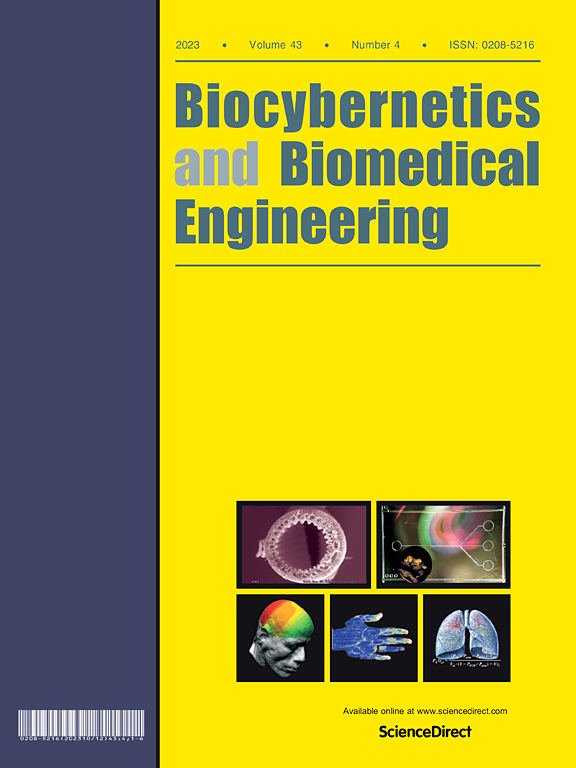一种智能血流动力学反应分析方法,实现亨廷顿病的预后和诊断
IF 6.6
2区 医学
Q1 ENGINEERING, BIOMEDICAL
引用次数: 0
摘要
由于亨廷顿舞蹈症(Huntington's disease,HD)的临床首发症状不具有特异性,因此开发可靠且经济高效的亨廷顿舞蹈症(HD)检测系统是一项极具挑战性的任务。为了应对这一挑战,本研究首次通过标准分解技术和动态映射神经网络,在功能性近红外光谱(fNIRS)分析的基础上,全面集中地提出了一种自动化的亨廷顿舞蹈症检测系统。fNIRS是一种极具成本效益且更加精细的神经成像模式,可无创地测量血流动力学反应和神经血管耦合机制。考虑到血红蛋白浓度变化的非稳态性,所提出的系统开发了一种新的基于 fNIRS 的 HD 生物标记,即时变奇异值,以描述氧合血红蛋白和脱氧血红蛋白信号的时空特征。利用支持向量机、递归神经网络和级联前向神经网络进行了分类,以区分健康对照组(HC)和无症状(Pre-HD)或有症状(SHD)的 HD 受试者。此外,在一项比较研究中,还分别测试了轨迹矩阵大小、HD 临床类别、发色团类型和脑区对检测性能的影响。为了评估所提出的系统,我们使用了 fNIRS 数据集,其中包括 12 个 Pre-HD、15 个 SHD、29 个 Pre-HD 的 HC 和 33 个 SHD 的 HC。该方法的准确率非常高,Pre-HD 与 HC 相比达到了 95.61%,SHD 与 HC 相比达到了 95.63%。对比分析结果表明,该系统性能卓越,对影响因素具有很高的鲁棒性,在计算成本和检测性能之间实现了更好的权衡。本文章由计算机程序翻译,如有差异,请以英文原文为准。
An intelligent hemodynamic response analysis method to achieve prognosis and diagnosis of Huntington’s disease
The development of a reliable and cost-effective Huntington’s disease (HD) detection is a challenging task due to non-specific clinical first symptoms. To address the challenge, this is the first study to comprehensively focus on proposing an automated HD detection system based on functional near-infrared spectroscopy (fNIRS) analysis through a standard decomposition technique and dynamic mapping neural networks. fNIRS is a highly cost-effective and more refined neuroimaging modality that noninvasively measures hemodynamic responses and neurovascular coupling mechanisms. Considering the non-stationary nature of the hemoglobin concentration changes, the proposed system has developed a new fNIRS-based biomarker of HD, namely time-varying singular value, to characterize the spatiotemporal characteristics of the oxyhemoglobin and deoxyhemoglobin signals. The classification has been performed using a support vector machine, recurrent neural network, and cascade forward neural network to discriminate healthy controls (HC) from presymptomatic (Pre-HD) or symptomatic HD (SHD) subjects. Moreover, in a comparative study, the effects of trajectory matrix size, clinical categories of HD, type of chromophores, and brain regions have been tested on the detection performance, separately.
To evaluate the proposed system, the fNIRS dataset of 12 Pre-HD, 15SHD, 29 HC for Pre-HD, and 33 HC for the SHD has been used. The method has achieved remarkable accuracy rates of 95.61% for Pre-HD vs. HC and 95.63% for SHD vs. HC. The comparative analysis leads to the outstanding performance of this system and its high robustness against affecting factors, providing a better trade-off between computational costs and detection performance.
求助全文
通过发布文献求助,成功后即可免费获取论文全文。
去求助
来源期刊

Biocybernetics and Biomedical Engineering
ENGINEERING, BIOMEDICAL-
CiteScore
16.50
自引率
6.20%
发文量
77
审稿时长
38 days
期刊介绍:
Biocybernetics and Biomedical Engineering is a quarterly journal, founded in 1981, devoted to publishing the results of original, innovative and creative research investigations in the field of Biocybernetics and biomedical engineering, which bridges mathematical, physical, chemical and engineering methods and technology to analyse physiological processes in living organisms as well as to develop methods, devices and systems used in biology and medicine, mainly in medical diagnosis, monitoring systems and therapy. The Journal''s mission is to advance scientific discovery into new or improved standards of care, and promotion a wide-ranging exchange between science and its application to humans.
 求助内容:
求助内容: 应助结果提醒方式:
应助结果提醒方式:


